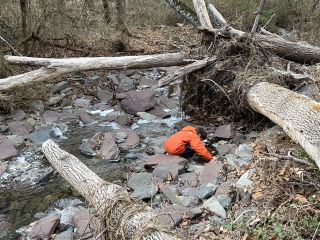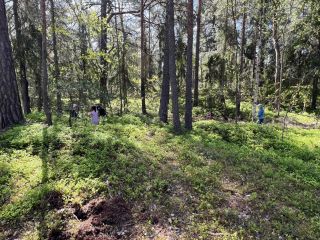Education
Benefits of an Outdoor Education Class
Assessing socio-emotional skills and development among child participants.
Posted December 16, 2022 Reviewed by Ekua Hagan
Key points
- An in-depth study of a six-week-long outdoor education course observed the effects of outdoor play on 5-to-8-year-old participants.
- The study participants were high in self-regulation, motor skills, and appreciation of nature. They also took risks on class hikes.
- The study shows promising evidence that time spent outdoors and learning about nature is highly beneficial for young kids.

In a world in which structured activity (Pynn; Watchman), resumé building, and indoor tendencies (Cleland) abound—and outdoor play has proven to be the safest way to play due to pandemic conditions—encouraging outdoor play seems to be more important than ever.
The benefits of outdoor play are numerous. To name a few, playing outside results in improvements in overall behavior, social skills, self-control, and attention, and less inhibition and more assertiveness. Outdoor play also leads to increases in physical activity, which in turn leads to fewer health complaints.

In other countries—such as Scandinavian countries—outdoor play is encouraged, regardless of weather (see McGurk, 2017). Forest preschools and kindergartens are growing in abundance, but are less common in the United States. Therefore, finding even after-school or weekend outdoor education programs such as the Nature at Heart School can be like finding diamonds in the rough.
I, along with two student research assistants, was fortunate enough to begin an in-depth study this fall semester of 2022 on the impact of a six-week-long outdoor education course at the Nature at Heart School on its young participants. We recruited seven children between the ages of 5 and 8, along with their parents, to participate. Participation involved pre- and post-class parental surveys, detailed observations of the children at each class meeting, and post-class interviews with the children.
For each of the assessment tools, we devised questions that addressed five main categories: self-reliance, self-regulation, curiosity and risk-taking, motor skills, and appreciation of and connection to nature. These categories were chosen in conjunction with the school’s founders, since they represent core values and aims of the program. They also reflect the benefits from outdoor play that have been suggested by previous research (e.g., Hinkley et al., 2017; 2018; Keane et al., 2017; Kemple et al., 2016).
In this post, I will report primarily on what we observed in the classes but will post more in the future about the results of the parent reports and child interviews. The class we observed was a drop-off class for children ages 5-8. The class is divided into four main sections: free play, circle time, a nature walk, and nature journaling. We corroborated with the class’s teacher to develop points to observe during each of these four sections that would assess the five categories mentioned above. For each behavior, it was noted whether the child engaged in it never, rarely, sometimes, frequently, or always. (For more, see the Nature at Heart photo gallery).
For example, for self-reliance, we observed times when the children initiated play on their own or with others, ventured off on their own to explore, or participated in nature journaling without prompting. For self-regulation, we noted when children followed the rules, acted appropriately with their teacher or peers, and separated smoothly from their parents at drop-off. For curiosity and risk-taking, times when children asked questions about things they observed, or about things they were learning, and times when they took risks during the nature walk were recorded.
To assess motor skills, we logged times when they walked confidently, balanced (e.g., on fallen trees or on rocks), or crossed tricky/rugged areas with self-assurance. Finally, for appreciation of and connection to nature, we took note of contentment with the weather, comfort with getting dirty or wet, pointing out things in nature, and playing with natural materials.
Results indicated that across all seven children, proportion scores were highest in the self-regulation, motor skills, and appreciation of and connection to nature categories. It will be important to assess whether these skills and traits were already high in this group, or have improved after several sessions of taking this class. Our plan for next semester will help us to determine this (see below).
Children in the classes were observed taking risks, especially on the nature walk. They climbed high on their own, climbed trees and hung from branches, rolled down hills, walked across/balanced on rocks, hiked on rockier/less even paths, balanced on logs, walked through streams/rivers, and ran in the rain. They rarely asked for help—even when stuck.
Scores in the self-reliance category were surprisingly low. It is possible, however, that the behaviors selected for self-reliance simply were not conducive to the set-up of the class (e.g., most children stuck with the group), and so when we revisit the same children at another session in the winter, we will reassess the best questions/behaviors to look for to demonstrate self-reliance in the context of this hour-long class.
Overall, it appeared from the observations that the children were engaged, happy to be in class (regardless of weather), and comfortable with the content of the instructional time as well as the physical demands of the hike. It is difficult to truly measure the impact of the class on a small sample in just one six-week period, so we will collect further data in a winter session (February-March) of the course. But it was clear even from just the short time of observation that the children were strong, independent, and appreciative of nature and time spent outside.
In the spring semester of 2023, we will recruit a sample of children from a similar demographic and the same geographic area to compare to this group of outdoor education students in terms of their self-reliance, self-regulation, curiosity and risk-taking, motor skills, and appreciation of and connection to nature. We will also compare the Nature at Heart students’ progress in these areas from September 2022 (when the first session began) to March 2023 (when the next session will end). I am confident that we will be able to show clear evidence corroborating what previous research has already suggested—that time spent outside is nothing but beneficial for children.
Note: This work could not have been completed without the exceptional time and efforts devoted by Cece Cream and Diamond Diaz. A special thanks also to the teachers, students, and parents from the Nature at Heart School for letting us work so closely with them.




